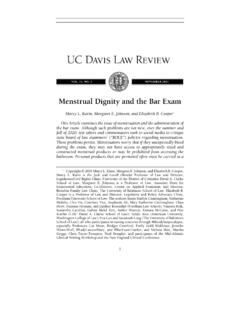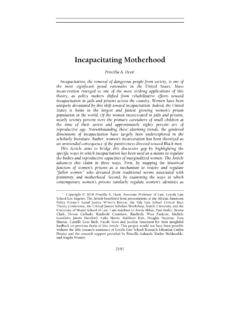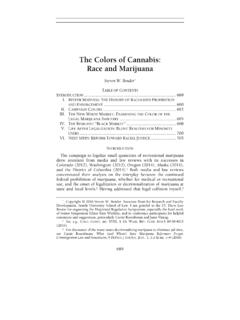Transcription of Preparing for Disaster: Protecting the Most Vulnerable in ...
1 Preparing for Disaster: Protecting the Most Vulnerable in Emergencies Sharona Hoffman . Many federal, state, local, and private entities are investing significant resources in disaster readiness initiatives. Often disregarded in these initiatives, however, are the special needs of Vulnerable populations during disasters. In the context of emergencies, Vulnerable groups may include individuals with disabilities, pregnant women, children, elderly persons, prisoners, certain members of ethnic minorities, people with language barriers, and the impoverished. The fate of the disadvantaged during disasters has received little attention in the legal literature, and this Article begins to fill that gap. Through an examination of normative distributive justice arguments, existing federal and state civil rights provisions, and emergency response laws, it argues that existing legal and ethical frameworks entitle Vulnerable populations to significant protection.
2 It also, however, highlights the shortcomings of the current statutory scheme as it relates to the needs of the disadvantaged during disasters and urges legislators to supplement these laws with additional requirements. Moreover, the Article argues that for Vulnerable populations, successful disaster response is dependent upon careful planning. With this in mind, the Article develops a proposal for statutory provisions that will mandate adequate preparation to safeguard the welfare of the Vulnerable in emergencies.. Senior Associate Dean for Academic Affairs, Co-Director of Law-Medicine Center, Professor of Law, and Professor of Bioethics, Case Western Reserve University School of Law; Member, The Center for Child Health and Policy at Rainbow Babies &. Children's Hospital, Cleveland, Ohio. , Wellesley College; , Harvard Law School; in Health Law, University of Houston Law Center.
3 Professor Hoffman served as a Guest Researcher at the Centers for Disease Control and Prevention's Public Health Law Program from January to April 2007. I would like to thank Jessica Berg, Leona Cuttler, Jonathan Entin, Tony Moulton, Andy Podgurski, and Ani Satz for comments on drafts of this paper. I am also grateful to Ramsay Hoguet for his excellent research assistance. 1491. 1492 University of California, Davis [Vol. 42:1491. TABLE OF CONTENTS. INTRODUCTION .. 1493. I. Vulnerable POPULATIONS .. 1498. A. Individuals with Disabilities .. 1499. B. Elderly Persons .. 1501. C. Pregnant Women .. 1501. D. Children .. 1502. E. Prisoners .. 1504. F. Economically Disadvantaged Minorities, Undocumented Workers, and Individuals with Language Barriers .. 1505. II. NORMATIVE 1507. A. Utilitarianism .. 1508. B. Equal Chances .. 1510. C. The Best Outcome for the Least Well Off .. 1511.]
4 D. What Ethics Teaches Us .. 1513. III. THE LAW AND Vulnerable POPULATIONS .. 1516. A. General Legal Protections for the Vulnerable .. 1516. 1. Federal Protections .. 1516. a. Constitutional Provisions .. 1516. (1) The Equal Protection Clause .. 1516. (2) The Eighth Amendment .. 1519. b. Statutory Protections .. 1522. (1) The Americans with Disabilities Act and the Rehabilitation Act .. 1522. (2) Title VI of the Civil Rights Act of 1964 .. 1526. 2. State Protections .. 1528. a. Constitutional and Statutory 1528. b. Common Law Remedies Through Tort .. 1530. B. Emergency Statutes Addressing the Needs of Vulnerable 1531. 1. Federal Law and Executive 1532. 2. State 1535. IV. RECOMMENDATIONS FOR AMENDING EXISTING LAW TO. IMPROVE ASSISTANCE FOR Vulnerable POPULATIONS IN. 1537. A. Where Existing Law Falls Short .. 1538. B. Specific Recommendations .. 1540. 1. Enhancing Accountability.
5 1540. 2. Detailed Planning Guidance .. 1541. 1546. 2009] Preparing for Disaster 1493. INTRODUCTION. Preparing for disasters has been high on the agendas of many federal, state, local, and private entities for several For example, the Centers for Disease Control and Prevention ( CDC ) and state public health departments are undertaking major emergency planning initiatives, including extensive training and educational Several recent governmental reports and statements also address emergency readiness in the United The federal government has spent over $10 billion on emergency preparedness activities since These efforts, however, often disregard the special needs of Vulnerable populations. During and after a catastrophic event, Vulnerable populations may include individuals with disabilities, pregnant women, children, the elderly, prisoners, ethnic minorities, people with language barriers, and the A review of 1.
6 Dennis P. Andrulis et al., Preparing Racially and Ethnically Diverse Communities for Public Health Emergencies, 26 HEALTH AFF. 1269, 1269 (2007) ( The White House, Congress, and State and local governments have made emergency preparedness one of their highest priorities. ); Aaron Katz et al., Preparing for the Unknown, Responding to the Known: Communities and Public Health Preparedness, 25 HEALTH AFF. 946, 946. (2006) (finding that bioterrorism preparedness remains a high priority for federal, state, and local governments and that the capabilities of local public health and emergency response agencies had improved significantly since 2004). 2. See Public Health Security and Bioterrorism Preparedness and Response Act of 2002, 42 247d-4(a)(3) (2006) (providing that Secretary shall expand, enhance, and improve the capabilities of the Centers for Disease Control and Prevention relating to [public health emergency] preparedness ); see also Pandemic and All-Hazards Preparedness Act of 2006, 42 247d-3a (2006) (establishing grants for state and local governments to undertake activities designed to enhance public health emergency preparedness); Centers for Disease Control & Prevention, Public Health Law Program, (last visited Feb.)
7 19, 2009) (describing emergency preparedness activities of CDC's Public Health Law Program); Washington State Department of Health, Public Health Emergency Preparedness and Response Preparedness: Information for Local Health Agencies and Health Care Providers, (last visited Feb. 19, 2009). 3. See generally DEP'T OF HOMELAND SEC. OFFICE OF INSPECTOR GEN., FEMA'S. PREPAREDNESS FOR THE NEXT CATASTROPHIC DISASTER (2008), available at http://. ; GOV'T ACCOUNTABILITY. OFFICE, EMERGENCY MANAGEMENT: OBSERVATIONS ON DHS'S PREPAREDNESS FOR. CATASTROPHIC DISASTERS (2008) (statement of William O. Jenkins, Jr., Dir. Homeland Sec. & Justice), available at 4. Rebecca Katz & Jeffrey Levi, Should a Reformed System Be Prepared for Public Health Emergencies, and What Does That Mean Anyway?, 36 MED. & ETHICS 716, 717 (2008). 5. ASS'N OF STATE & TERRITORIAL HEALTH OFFICIALS, DEP'T OF HEALTH & HUMAN.
8 1494 University of California, Davis [Vol. 42:1491. thirty-seven national pandemic preparedness plans from Europe, Asia and the Pacific Rim, the Middle East, Africa, and the Americas revealed that none of the plans suggested any systematic attempt to identify disadvantaged Furthermore, fewer than twenty-five plans considered the needs of one or more economically or socially disadvantaged group[s]. 7. Inadequate preparation for the needs of Vulnerable populations can lead to catastrophic consequences. The disadvantaged could suffer large death tolls, as illustrated by Hurricane Katrina, in which over 1,800 individuals died because they were unable to evacuate the The infirm elderly, poor, and disabled were the most likely to die in that notorious Members of Vulnerable populations who survive could suffer permanent, debilitating injuries and become unable to work, live independently, and care for themselves.]
9 American taxpayers who pay for public safety-net programs would thus absorb the cost of increased use of such programs and loss of economic productivity. As demonstrated in the aftermath of Hurricane Katrina, a failed emergency response could also cause the government to suffer humiliation and the public to lose faith in those responsible for its These prospects are alarming given the variety of potential emergencies that experts predict we will face in the SERVS., AT-RISK POPULATIONS AND PANDEMIC INFLUENZA: PLANNING GUIDANCE FOR STATE, TERRITORIAL, TRIBAL, AND LOCAL HEALTH DEPARTMENTS 3-4 (2008), available at http://. [hereinafter ASTHO];. HEALTH SYS. RESEARCH, INC., ALTERED STANDARDS OF CARE IN MASS CASUALTY EVENTS 30-31. (2005), available at ; Kathleen Tierney, Social Inequality, Hazards, and Disasters, in ON RISK AND DISASTER: LESSONS FROM. HURRICANE KATRINA 109, 112-20 (Ronald J.)
10 Daniels et al. eds., 2006); Public Health . Seattle & King County, Vulnerable Populations Action Team (VPAT), (last visited Feb. 20, 2009). 6. Lori Uscher-Pines et al., Planning for an Influenza Pandemic: Social Justice and Disadvantaged Groups, 37 HASTINGS CENTER REP. 32, 38 (2007). 7. Id. 8. David Hall, Katrina: Spiritual Medicine for Political Complacency and for Social Activists Who Are Sleepwalking, 23 HARV. BLACKLETTER 1, 2 (2007). 9. Katherine Pratt, Deficits and the Dividend Tax Cut: Tax Policy as the Handmaiden of Budget Policy, 41 GA. L. REV. 503, 558-59 (2007) (asserting that over 75 percent of those who died in Katrina were over 60 years old). 10. L. Darnell Weeden, Hurricane Katrina and the Toxic Torts Implications of Environmental Injustice in New Orleans, 40 J. MARSHALL L. REV. 1, 35 (2006) ( As a result of governmental conduct since Katrina, almost all Louisianans now seem to share a distrust of the government.









